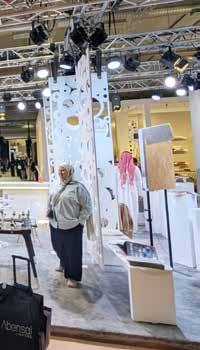

Written by Alys Bryan, Editorial Director designinsiderlive.com






Written by Alys Bryan, Editorial Director designinsiderlive.com



Couldn’t join us at INDEX Saudi Arabia 2025? This event report brings you the scale, energy, and opportunity of one of the most significant gatherings for the commercial interiors sector in the region.
You’ll gain exclusive insight into the enormity of opportunities within Saudi Arabia’s fast-growing design and hospitality landscape, where investment and innovation are rapidly reshaping expectations for future projects.
We share conversations with a breadth of industry voices, including developers, operators, designers, fit-out companies, and suppliers, each offering their perspective on the country’s evolving market. This includes highlights from Saudi Arabian and international suppliers across a wide range of product types, reflecting the diversity and creativity on show throughout the exhibition.
The Department for Business and Trade also lends its insight, highlighting how UK suppliers can engage with and support Saudi Arabia’s ambitious pipeline. Alongside this, we spotlight the Commercial Interiors UK members who exhibited, underlining the strength, expertise, and adaptability they bring to international projects.
Finally, we reflect on the lasting impressions of INDEX Saudi Arabia 2024, considering how the event has positioned itself as a vital platform for forging partnerships and unlocking opportunities in one of the world’s most dynamic markets.

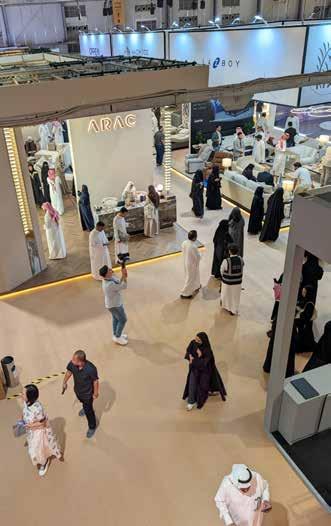


INDEX Saudi Arabia delivered three consistently busy days, with the exhibition hall alive from 4pm until 10pm each evening. Visitors were highly engaged, actively seeking conversations with brands and requesting further information, reflecting the strong level of interest in the products and services presented.
The stands were well built and executed to the standard expected of an international event, reinforcing the professional quality of the show. Exhibitors were generous with their onstand hospitality, helping to create a welcoming environment, though a higher quality food and drink provision across the event would have been appreciated.
Overall, INDEX Saudi Arabia proved a positive and rewarding experience, both in terms of the opportunities it generated and the insight it offered into the region’s growing appetite for high-quality commercial interiors.
To complement our perspective, we invited recent UK graduate, friend of Design Insider, and Riyadh resident Farhan Rehman to share his own experience of INDEX Saudi Arabia.
FARHAN REHMAN FOUNDER AND CCO OF AKAID
BIID ASSOC, SBID ASSOC
With a background in interior design, project management and intertwined within the design ethos of the middle east and UK, Farhan is the founder of Akaid, an interior design studio that fuses contemporary luxury aesthetic with cultural heritage crafting distinctive experiences across diverse sectors.
‘Attending Index Saudi was an energising experience that went far beyond simply walking an exhibition floor. From the moment I arrived, I was immersed in a mix of bold concepts and rich cultural references that reflected Saudi Arabia’s ever evolving design landscape.
Meeting regional designers opened up fresh conversations around how design shapes future ways of living. Though, the design talk stage I found that the sightlines for the audience could have been more thoughtfully planned to help engage guests. Nevertheless, I left with a renewed sense of possibility within the design landscape across the MENA region.’





APRIL 2016, HIS ROYAL
MOHAMMED BIN SALMAN LAUNCHED VISION 2030, A NATIONAL STRATEGIC FRAMEWORK DESIGNED TO DIVERSIFY SAUDI ARABIA’S ECONOMY, REDUCE ITS DEPENDENCY ON OIL, AND ENHANCE QUALITY OF LIFE ACROSS THE KINGDOM 1 . DEVELOPED BY THE COUNCIL OF ECONOMIC AND DEVELOPMENT AFFAIRS (CEDA), THE VISION LAYS OUT AMBITIOUS GOALS FOR TOURISM, CULTURE, INFRASTRUCTURE AND INNOVATION, CREATING PROFOUND OPPORTUNITY FOR THE GLOBAL DESIGN AND SUPPLIER INDUSTRIES.
1. Vision 2030 for Designers and Suppliers
Vision 2030 highlights tourism as a central economic pillar, with a target of attracting 150 million visitors annually by 20302
To support this, the Kingdom is investing over SAR 220 billion (USD 58 billion) in hospitality and tourism infrastructure3, including the delivery of 362,000 new hotel rooms4
This presents a significant scope of work for architects, interior designers, FF&E consultants, and material suppliers, particularly in hotel development, retail, transport hubs and mixed-use destinations. Opportunities exist at every project phase, from master planning and concept to procurement and delivery.
As Vision 2030 states:
“We will work with the private sector to localize the tourism industry and create unique destinations that highlight our culture and natural diversity.”5
Suppliers who can deliver at scale with sustainability and quality guarantees will find themselves central to this transformation.
2. Tourism, Faith and Infrastructure
Religious tourism remains a priority. The plan includes increasing Umrah pilgrim numbers from 8 million to 30 million annually6. Major developments in Makkah and Madinah, such as the Rua Al Madinah masterplan and the Makkah Route initiative, are designed to improve access, expand accommodation, and elevate the visitor experience.
For designers, this means balancing cultural reverence with architectural innovation. Projects must account for thermal comfort, high-volume footfall, and spiritual symbolism, often within tight delivery timelines.
As the Vision declares:
“We aim to enrich pilgrims’ religious and cultural experiences by offering world-class services and preparing historical and cultural sites for visitors.”7
Whether designing public realm, prayer halls, hotels or transit stations, practitioners must approach these projects with both ambition and humility.

From NEOM to Qiddiya, The Red Sea Project to Diriyah Gate, Saudi Arabia’s gigaprojects are driving global headlines. The sheer scale of these developments, and their overlapping timelines, demands agile design teams and dependable supply networks.
Vision 2030 places strong emphasis on local content, international partnerships, and technology transfer. Companies that bring regional knowledge, build local capacity and contribute to skill development will be valued long-term collaborators.
“We will localize industries, improve product quality and standards, and support the transfer of knowledge and expertise to the Kingdom.”8
Working in Saudi Arabia requires cultural fluency, operational rigour, and supply chain resilience. For those willing to meet the moment, the reward is long-term engagement with one of the most significant transformation projects in the world.
References
1. Vision 2030 Kingdom of Saudi Arabia, official overview. https:// www.vision2030.gov.sa
2. Ministry of Tourism, “Tourism Development Strategy,” 2023 update.
3. Public Investment Fund (PIF) data via Ministry of Investment, 2024.
4. Colliers International, Saudi Arabia Hotel Market Report, Q1 2024.
5. Vision 2030, Tourism Sector Strategic Objectives, Chapter 3.
6. General Authority for Statistics (GaStat), Pilgrimage Data 2023.
7. Vision 2030, Pillar: A Vibrant Society – Objective 3.
8. Vision 2030, Economic Pillar: Thriving Economy – Localisation Strategy.
AT THE HEART OF THE UK PAVILION AT INDEX SAUDI ARABIA 2025, THE DEPARTMENT FOR BUSINESS AND TRADE (DBT) IS LEADING THE CHARGE IN CONNECTING UK DESIGN SUPPLIERS TO ONE OF THE MOST AMBITIOUS MARKETS IN THE WORLD. FROM GIGA-PROJECTS TO CULTURAL INITIATIVES, SAUDI ARABIA IS INVESTING AT AN UNPRECEDENTED SCALE, AND IT WANTS BRITISH DESIGN AT THE TABLE.
We spoke with Graham Ellis, Middle East Business Specialist at DBT, and Safwan Syed, Trade Adviser for the Creative Cluster at the British Consulate in Jeddah, about what’s driving the demand, how UK companies can get involved, and why now is the moment to act.
A Market of Unmatched Scale
“There’s over a trillion dollars worth of construction underway,” said Graham Ellis. “When we’re talking about projects in Saudi, we’re not just talking about cities, we’re talking about territories, about entire regions being developed. It’s going to continue for the next 30, 40, even 50 years. It’s absolutely amazing what’s happening here, and it’s setting new standards globally.”
The transformation is driven by Vision 2030, Saudi Arabia’s national development strategy, which is reshaping the Kingdom’s economy and identity. And this wave of development isn’t limited to infrastructure, it’s rapidly expanding into design, interiors, culture, heritage, tourism, and more.
“Saudi Arabia is a very big market with loads of opportunities,” added Safwan Syed. “There’s giga projects, mega projects, and activity across the public and private sector. It covers everything, architecture, fit-outs, FF&E, furniture, entertainment, events, sport, tourism, culture, arts, heritage, film, and media. It’s an incredible breadth of demand.”
“There’s a strong interest in UK design and products,” Graham explained. “The Saudis already value what the UK brings, quality, creativity, attention to detail. They know they’re going to get something authentic and reliable.”
The reputation of British design is reinforced by the UK government’s Great Futures campaign, an initiative that is not just about trade, but about long-term collaboration between the UK and Saudi Arabia.
“Great Futures is very much about building a relationship between the two countries,” Graham said. “It reflects the societal changes happening in Saudi, how they’re bringing in tourists, culture, education, and shows how the UK can be a trusted partner in all of this.”
The urgency comes down to timing. According to Safwan, many projects have now moved past initial infrastructure phases and into supply chain mobilisation, the moment when UK suppliers become most relevant.
“They’ve already finished the construction phase,” he said. “Now comes the part where design, interiors, fit-out, and experience really matter. That’s where UK creative industries come into play.”
For UK businesses, particularly SMEs, this is a pivotal moment.
“If you’re a UK company looking to grow, this is where you need to be,” Graham said. “Markets in the UK and Europe can be tough. But Saudi is expanding fast. If you want to grow your business, you need to think internationally, and Saudi is a perfect place to do it.”
Not sure where to start? The answer is simple, reach out.
“The best first step is to talk to people like us who are based in market,” said Safwan. “We’ll help you understand the landscape,

the licensing, registration, and everything else needed to penetrate the market. We support UK companies from the start right through the journey, until they gain clients and expand.”
Graham added that seeing the market first-hand is essential.
“There are a lot of preconceptions about the region,” he said.
“But when you come here and meet the Saudis, you understand what they’re looking for and what matters to them. That’s how you succeed. You have to come out and see it for yourself.”
He recommends taking part in trade missions, exhibitions like Index Saudi Arabia, or even subscribing to his weekly Middle East market update.
“You won’t learn everything from behind a desk. Get on a plane, meet people, see the projects. It changes everything.”
Why the DBT, CIUK Partnership Works
At Index, DBT partnered with Commercial Interiors UK (CIUK) to create a dedicated UK Pavilion. The collaboration brings

together governmental reach and industry-specific expertise.
“DBT can build relationships at a government and institutional level,” said Graham. “But we rely on partners like CIUK to connect with the market directly. They know their members. They know the product. That partnership makes the whole system stronger.”
Safwan agreed, “The UK Pavilion sends a powerful message, that British design is present, serious, and invested. It shows Saudi stakeholders that we’re not just interested, we’re here.”
“UK suppliers need to realise that the Saudi market isn’t a shortterm trend,” Safwan said. “It’s a multi-decade investment in design and culture. The earlier you enter, the better positioned you’ll be to grow with it.”
“There’s plenty of support,” Graham added. “But it starts with being open to what’s out there. Great Futures isn’t just a slogan, it’s a real opportunity. And it’s happening now.”
THE SCALE OF OPPORTUNITY IN SAUDI ARABIA IS UNLIKE ANYTHING THE DESIGN INDUSTRY HAS SEEN IN DECADES. FROM VAST GIGA PROJECTS TO BOUTIQUE LUXURY DEVELOPMENTS, THE COUNTRY IS IN THE MIDST OF A DESIGN AND CONSTRUCTION REVOLUTION, AND BRITISH BRANDS ARE INCREASINGLY POSITIONING THEMSELVES TO PLAY A CENTRAL ROLE.
At Index Saudi Arabia 2025, held at Riyadh Front Exhibition Centre, a cohort of UK design suppliers joined forces under the Commercial Interiors UK (CIUK) Pavilion, facilitated by the Department for Business and Trade (DBT). The mission aimed to help British manufacturers, makers, and design firms connect with Saudi Arabia’s expanding creative economy, particularly within hospitality, leisure, and highend residential sectors.
For many, this wasn’t a first-time exploration, but a deepening of conversations already underway.
“We’ve worked on projects in Riyadh through European designers for more than a decade,” shared Andrew Cotgrove, Managing Director of Loomah, specialists in bespoke carpets and rugs. “But there’s a real sense now that it’s time to come here directly, meet people face-to-face, and build lasting partnerships.”
That sentiment was echoed by Simon Shuck, Managing Director of Inspired by Design, whose company specialises in bespoke lighting for luxury interiors.
“This is my fourth or fifth trade mission to the region,” he explained. “It makes a real difference having the UK Pavilion as a point of credibility, clients know you’re ready to do business and part of a trusted, established ecosystem.”
Across the board, one observation was unanimous: demand is high, timelines are short, and clients are seeking fast, dependable delivery, often with minimal compromise on design.
“We’re seeing a big appetite for quality British-made products,” said Beijou Jamaludin of Burgess Furniture. “Clients are drawn to UK craftsmanship and innovation, but they also expect quick turnaround. Being here allows us to speak directly with specifiers and decision-makers, explain our lead times, and help streamline the process.”
“There’s huge interest in British design,” added Kevin James of One-LUX, a manufacturer of emergency lighting and controls. “We’ve had great conversations with contractors and consultants. Many of them are looking to align with international suppliers who already understand the regulatory landscape.”
One of the biggest takeaways for all participants was how much ground could be covered in just a few days. The CIUK Pavilion offered each company a fully branded booth within a shared footprint, giving exhibitors visibility without the cost or complexity of going it alone.
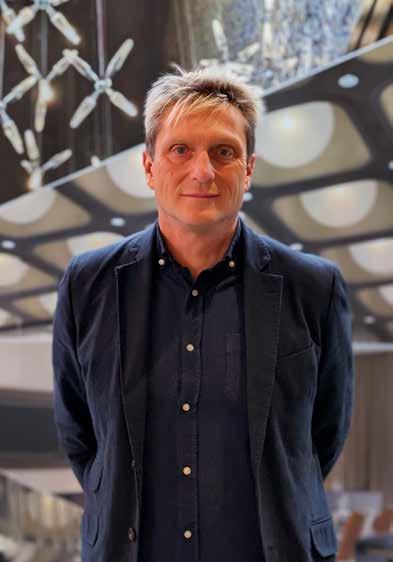



“We’ve had key decision-makers visit our stand, people involved in multi-million-dollar projects,” said Beijou. “We wouldn’t have met them otherwise. It’s been productive from day one.”
The benefits extended well beyond the exhibition hall. For first-time and returning participants alike, the support from CIUK and DBT proved invaluable.
“It’s not just about the stand,” explained Marwa Ismail of OneLUX. “CIUK helped coordinate logistics, organise meetings, and advise on everything from shipping to client introductions. That kind of support is crucial when entering a new market.”
Several companies also took advantage of being on the ground to conduct site visits and reconnect with existing clients in the region.
“The timing was perfect,” said Kevin. “We already had contacts here from previous trips, and being part of the mission gave us a reason to reengage. We were also able to explore opportunities outside the show, something that’s often overlooked.”
For newer exporters, the mission offered a unique way to test the waters with confidence.
“It’s a low-risk, high-reward way of understanding the market,” said Simon. “You get to meet competitors, collaborators, and clients. But most importantly, you get a real sense of what Saudi Arabia is looking for, and whether your business is a good fit.”
There’s no doubt the pace of development in Saudi Arabia is intense.
“Riyadh has quadrupled in size in 10 years,” noted Andrew. “Everywhere you look, there are cranes, infrastructure upgrades, and new buildings going up. But it’s not just volume, it’s ambition. The scale and design quality being demanded here is worldleading.”
“British companies bring something distinctive to the table,” added Marwa. “Whether it’s bespoke lighting, sustainable materials, or innovative controls, there’s appreciation for thoughtful design and manufacturing integrity.”
For companies still considering whether to explore the region, the message from those who’ve already taken the leap is simple: don’t wait.
“You have to come and see it for yourself,” said Kevin. “No amount of desk research can replace the insight you gain from walking the floor, speaking with buyers, and understanding the real opportunities.”
From brand exposure to business development, the CIUK Pavilion delivered impact at every level.
“This mission gave us the right setting, the right support, and, most importantly, the right people,” said Beijou. “It’s not just about showing up. It’s about being seen, being credible, and building something that lasts.”
As Saudi Arabia continues to open its doors to international collaboration, British design firms are poised to make their mark, one connection, one conversation, one project at a time.

AS ONE OF ISLAM’S TWO HOLIEST CITIES, MADINAH HOLDS DEEP SPIRITUAL AND EMOTIONAL SIGNIFICANCE FOR OVER 2 BILLION MUSLIMS AROUND THE WORLD. EACH YEAR, MORE THAN 20 MILLION PILGRIMS AND VISITORS COME TO THIS SACRED CITY, MANY TO PERFORM HAJJ OR UMRAH, OTHERS FOR SPIRITUAL AND CULTURAL TOURISM. WITH SAUDI ARABIA’S VISION 2030 AIMING TO WELCOME 30 MILLION UMRAH PILGRIMS ANNUALLY, THAT NUMBER IS ONLY SET TO GROW.
Yet today, Madinah’s hospitality infrastructure is under immense pressure. Occupancy rates remain consistently high throughout the year, and the supply of quality accommodation, especially within walking distance of Al-Masjid an-Nabawi, the Prophet’s Mosque, has not kept pace with rising demand. The result is a city with global religious importance that urgently needs a new hospitality model capable of hosting the world. That’s exactly what Rua Al Madinah Holding is building.
At the heart of this transformation is Saeed Albially, Executive Director of Design Development at Rua Al Madinah Holding, who spoke exclusively with Design Insider during INDEX Saudi Arabia 2025.
“We are developing 40,000 keys,” he explained. “This is the largest hospitality project in Madinah. It’s not just a series of hotels, it’s a new urban framework.”
The Rua Al Madinah project is vast in both ambition and footprint. It is being delivered through a series of super blocks, each structured like a miniature city with full-service hospitality,
public space, and integrated retail infrastructure.
“One super block we’re awarding shortly will include 11 hotels and 18 towers, around 4,800 keys in one project alone,” Saeed shared. “Each block also includes around 20,000 square metres of GLA for supporting retail, effectively a small mall for every cluster.”
This scale is necessary to meet growing demand. What was once a seasonal destination is now a year-round spiritual centre.
“Madina used to be busy mainly during Hajj and Ramadan,” he said. “Now, the city is alive year-round, and the occupancy rates are always high due to limited supply.”
This is not merely a development for Saudi Arabia. As Saeed explains, “we’re not building this for ourselves, we are building it for the Islamic world.”
Delivering such a development demands sensitivity, scale, and a deep respect for the religious and cultural expectations of visitors. Every aspect of design must balance spiritual purpose with modern hospitality expectations.

“We have a responsibility to ensure the best possible guest experience,” he said. “That includes how we design for climate, how we handle public space, and how we provide comfort and dignity to every visitor.”
With summer temperatures soaring in Madinah, climateresponsive design is non-negotiable. “It’s not just about buildings, it’s about creating a holistic environment that welcomes people from all over the world.”
At the project’s core is a hybrid approach to design development, strong in-house oversight complemented by world-class external consultants.
“I believe in having a strong internal design management team,” Saeed shared. “Rua Al Madinah handles all design management internally, working closely with lead consultants and subconsultants.”
Due to the complexity and sheer volume of the work, the team regularly partners with international firms, from the UK, the US, and across the Middle East. Some developments require up to three lead consultants per project.
So, what does Rua Al Madinah look for in its partners?
“First, we look at capacity. These are huge projects, and the firms must be able to handle the scale. But more importantly, we look at the project leadership. The right project director and design team make all the difference.”
For international suppliers and manufacturers, the Rua Al Madinah development presents an extraordinary opportunity, not just to supply goods, but to actively contribute to the design process.
“We are always open to meeting new suppliers,” Saeed affirmed. “Some bring us new materials, others offer insights that contribute to value engineering or improve constructability.”
But the process is far from casual. Rua Al Madinah applies rigorous standards from early engagement through to specification.
“We maintain a strong vendor list. Every specified product must have at least three or four qualified vendors, depending on the level, four-star, five-star, etc. This ensures quality, competition, and delivery reliability.”
What makes a supplier stand out? Innovation, quality, and the willingness to collaborate early. “We don’t want to design in isolation and then go to the market later. We expect suppliers to be part of the process.”
Rua Al Madinah Holding has already secured significant operator partnerships within its developments. Hyatt will oversee three new hotels, Grand Hyatt, Hyatt Regency, and Hyatt Place, totalling 1,729 keys, marking the group’s first brand entries into Madinah. Meanwhile, Marriott International has signed to operate eight hotels encompassing 4,400 rooms, across multiple brands located near the Prophet’s Mosque. Accor has also confirmed its participation in the development, committing to over 1,000 rooms, further diversifying the hospitality offering.
On the design front, Jacobs has been appointed to deliver comprehensive design solutions for 12 distinct hotel brands within one of the project’s super-blocks. KEO International Consultants is providing implementation oversight for another super-block, ensuring design integrity throughout the construction process. In parallel, Parsons Corporation has been tasked with project management consultancy across the wider

development, managing infrastructure delivery and quality control, including the construction of a major subterranean tunnel designed to enhance pedestrian access to the Holy Mosque.
Supporting the public realm, ICON is leading the landscape architecture strategy, shaping shaded corridors, open spaces, and intuitive navigation that reflect both the cultural heritage and the future-forward ambitions of the development.
Together, these global operators and design consultancies demonstrate Rua Al Madinah’s commitment to delivering a world-class religious and hospitality destination that aligns with the broader objectives of Vision 2030.
A Landmark Moment for Madinah and the Region Albially’s connection to the project runs deep. He has spent over a decade working on major developments in Madinah, and his personal commitment to the city is unmistakable.
“I’m proud to be working here. Madinah is our beloved city as Muslims, and we have a big role to play in shaping its future.”
As Saudi Arabia continues to diversify its economy and invest in world-class infrastructure through its Vision 2030 programme, hospitality design in cities like Madinah is a critical frontier, not just for developers and designers, but for global suppliers and manufacturers looking to leave their mark in the Kingdom.
Rua Al Madinah is not just a masterplan. It is a spiritual gateway, one that welcomes the best of global design, done with purpose!
NUHA ALQAHTANI, SENIOR INTERIOR DESIGNER, ARAC
AT THIS YEAR’S INDEX SAUDI ARABIA, WE HAD THE PLEASURE OF SPEAKING WITH NUHA ALQAHTANI, SENIOR INTERIOR DESIGNER AT ARAC, WHOSE DEEP COMMITMENT TO CRAFTSMANSHIP AND CLIENT EXPERIENCE IS REDEFINING EXPECTATIONS IN BOTH RESIDENTIAL AND HOSPITALITY DESIGN. KNOWN FOR HER OBSESSIVE ATTENTION TO DETAIL, NOT AS A QUIRK, BUT AS A PRINCIPLE, NUHA BRINGS AN EMPATHETIC, HUMAN-CENTERED PHILOSOPHY TO EVERY PROJECT SHE UNDERTAKES.
Based in Saudi Arabia, Arac is a full-service interior design studio offering comprehensive solutions from concept through to execution. Their services include spatial planning, bespoke design, material specification, and complete installation. Working across both residential and commercial sectors, Arac delivers immersive, tailored environments that reflect both client identity and lifestyle.
“Sometimes, suppliers find it challenging to work with us,” Nuha admitted with a smile. “Because we care about every single detail, from A to Z. Even the thread used in the fabric, the way the stuffing goes into a pillow or sofa. We ask to see everything, because those details matter.”
This level of dedication stems from a deep respect for the people who will inhabit the spaces she creates. “It’s not because we’re perfectionists for the sake of it,” she explained. “It’s because we care about our clients. They have an identity, and so do we. We try to bring those two identities together to create something luxurious and meaningful. You should be able to see that and feel it too.”
When designing private homes, Nuha goes far beyond style preferences. Her process begins by understanding the rhythms and realities of family life. “I always ask clients about their daily
routine. When you come home from school with your kids, which door do you enter through? Where do the children put their bags? These things matter,” she said. “Design should reflect how people actually live, not just how it looks for guests.”
She believes that a home must first serve the comfort and emotional needs of its residents. “Of course we want it to be beautiful, but first and foremost, it must reflect the family’s lifestyle, habits, and identity. Even when designing furniture, I ask, do you nap here? Do you watch TV here? Because that changes everything.”
In hospitality, where designers don’t know the end user personally, Nuha still brings the same empathetic mindset, this time through observation and shared experience. “I ask my colleagues, both men and women: when you stay in a hotel, what annoys you? What do you love?” she said. “We’re all part of the community and we live in these spaces too. As designers, we can identify the little things that don’t work, even when others can’t quite explain why.”
It’s those small insights, like a poorly placed chair or nowhere to place a suitcase, that shape a guest’s memory of a space. “Every decision affects the experience. So we test ideas, ask questions,

and research the standards. Then we create something new, something thoughtful, functional, and beautiful.”
Executing that vision requires collaboration with like-minded suppliers who understand Arac’s dedication to detail. “We appreciate our partners and include their names because they’re part of our success story,” Nuha shared.
At this year’s Index Saudi Arabia, Arac’s stand featured sculptural lighting from their French partner Sans Souci, whose installations blur the lines between function and art. “They bring light and art into the space” Nuha noted. Complementing the space were richly textured carpets supplied by ZuMa Design Consultants, Arac’s Dubai-based partner, adding warmth and material richness to the overall composition.
These relationships are crucial to achieving Arac’s signature, multi-material storytelling, combining marble, wood, textiles, and finishes in ways that engage all the senses.
Nuha is also deeply invested in the sustainability and performance of materials. “Sustainability is important, not just for the environment, but financially,” she explained. “If you want guests to come back again and again, everything needs to feel
high-quality. Nothing should feel cheap or plasticky, especially things that come into contact with skin, or lighting that’s too harsh or too dim. Good materials create good experiences.”
She sees design as a puzzle, where comfort, aesthetics, quality, and practicality all must align. “When all the parts connect, it makes sense. It becomes a complete story.”
Nuha’s passion is fed by constant exploration. “I love to travel and stay in different hotels, even here in Saudi,” she said. “Each place has its own way of doing things, and I take mental notes: this sink height works well, that light fixture is awkward. Those details stay with me. Experiencing design firsthand is what makes good design possible.”
And there’s no better time to be doing it. “Saudi Arabia is full of opportunity right now. Every sector, mosques, commercial spaces, homes, is evolving. People are more open to new ideas and they trust designers more than ever. It’s a very exciting time.”
For Nuha, it all comes back to the power of experience. “When someone enters a space and connects with it through all their senses, they’ll never forget it,” she said. “And if it’s a commercial space, they’ll want to come back. That’s what really counts!”


THE LIGHTING OFFER AT THIS YEAR’S INDEX SAUDI SHOWCASED A COMPELLING MIX OF DESIGN DIRECTIONS — FROM CONTEMPORARY GEOMETRIC FORMS TO LARGE-SCALE, ARTDRIVEN INSTALLATIONS, SUCH AS THOSE FEATURED ON THE ARAC STAND.
Astro Lighting – A Commercial Interiors UK member returning for the second consecutive year with Middle East distributor Abensal. Astro entered the Saudi market early, recognising the importance of partnering with an established regional specialist to meet cultural and technical requirements.
Estiluz – A Spanish brand founded in Barcelona in 1969 and now run by the second generation. With metalwork in their soul, Estiluz has built a lighting portfolio where craftsmanship remains at the heart of every design.
Karman – An Italian lighting brand celebrated for its poetic, unconventional designs, Karman blends artistry with technical innovation. Based in the heart of Italy’s design region, the brand brings a theatrical approach to architectural and decorative lighting.
Fafferano - An Italian brand bringing colour, character and creativity to the lighting scene, Fafferano is a global leader in portable lighting solutions. With a new Saudi Arabian distributor in place, Fafferano is actively looking to grow its presence in the Kingdom’s evolving hospitality and residential sectors.
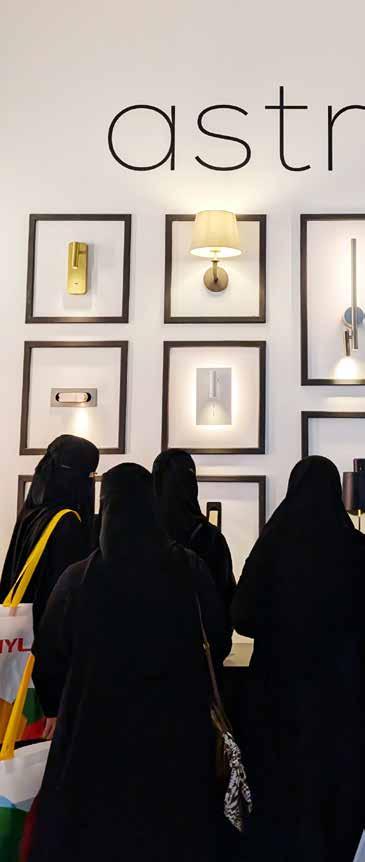





WHILE WE ANTICIPATED A BROADER SHOWING FROM TEXTILES BRANDS AT INDEX SAUDI ARABIA, A SELECT GROUP OF EXHIBITORS PRESENTED OFFERINGS THAT MET EXPECTATIONS IN QUALITY AND APPLICATION, THOUGH FEW PUSHED CREATIVE BOUNDARIES OR INTRODUCED NEW TRENDS TO THE MARKET, OTHER THAN THE COLLABORATION BETWEEN SARITA HANDA AND KRISTINA ZANIC.
Sarita Handa x Kristina Zanic – A creative collaboration between Indian textile specialists Sarita Handa and Saudi-based global design studio Kristina Zanic, bringing beautiful upholstery and curtain textiles into distinctive hospitality projects.
SFC Design - Returning to Index Saudi for the second year, Turkish manufacturer SFC Design presented a diverse range of indoor and outdoor fabrics. Aiming to deliver high-performance textiles suited to hospitality, residential, and commercial applications.
Muir England - Founded by Henry Rawson over 35 years ago as a white-label manufacturer for UK high street retailers, Muir England has since evolved into its own international brand, recently launching a dedicated showroom in Dubai to support regional growth.
Leata - Founded in Dubai in 1997, Leata is a flooring and wallcovering specialist known for its bespoke, made-on-demand service. Now firmly established in the Saudi market, the brand offers a highly personalised, one-to-one client experience across residential and commercial projects.





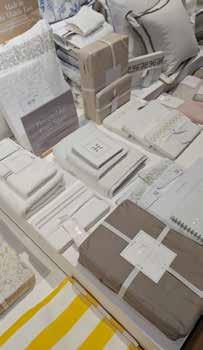

FROM REGIONALLY ESTABLISHED MANUFACTURERS TO FIRST-TIME EXHIBITORS, THE FLOORING AND RUG BRANDS AT INDEX SAUDI ARABIA SHARED A COMMITMENT TO BESPOKE DESIGN AND EXCEPTIONAL CRAFTSMANSHIP—WHETHER ROOTED IN PLAYFUL CREATIVITY OR PROVEN PRODUCTION EXPERTISE.
ARTEX INDUSTRIAL INVESTMENT CO – Riyadh-based specialists in high-quality yarn, rug, carpet, and blanket manufacturing. Their striking stand boldly demonstrated their capabilities and craftsmanship.
Loominology - Loominology brought a playful edge to the flooring offer with their collection of sculptural, shape-driven rugs. Known for blending contemporary design with fine craftsmanship, the brand creates distinctive textile pieces that double as functional art.
Loomah - Exhibiting in Saudi Arabia for the first time, Loomah showcased their extensive portfolio of high-quality rugs, tailored for both high-end residential and commercial interiors. Known for their bespoke service and exceptional craftsmanship, the brand used the opportunity at Index Saudi Arabia to better understand local market demands and build valuable new relationships within the region.




YANA SVETLOVA WALLCOVERINGS – A premium Dubai-based brand founded in 2015 by interior designer Yana Svetlova. With a showroom in Dubai, their exquisite wallcoverings feature surface decoration with 3D elements and beading.
Fantoni - Italian brand Fantoni presented a selection of acoustic and architectural workspace solutions, including their immersive 4akustik® installation and the award-winning Woods table system, designed with Metrica. The 3D acoustic forms were particularly engaging and tactile, inviting visitors to experience their performance firsthand.
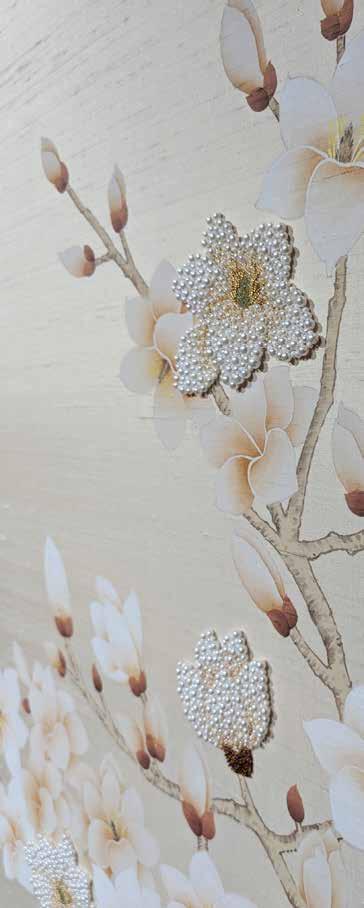


WE SPOKE WITH TWO PASSIONATE DESIGNERS BRINGING TOGETHER GLOBAL DESIGN EXPERTISE AND REGIONAL INSIGHT. GABRIELA SKROBACKA, FURNITURE DESIGNER AND ART DIRECTOR AT .MDD, AND ASEEL AL TUWAIJRI, JUNIOR INTERIOR DESIGNER AT ROAR, WALKED US THROUGH THEIR CREATIVE COLLABORATION, AND THE IMMERSIVE STAND THEY BROUGHT TO LIFE ON THE SHOW FLOOR.
Based in Poland, .mdd is a European furniture brand known for producing contemporary workplace solutions and collaborating with leading designers from across Scandinavia, Spain, and beyond. “Our in-house design team is small,” explained Gabriela, “but we regularly work with well-known international designers. Collaboration is a huge part of our approach, and we’d love to work with Saudi designers in the future.”
For this year’s stand at Index Saudi Arabia, .mdd teamed up with Dubai-based interior design studio Roar to create a spatial experience that explored how furniture shapes the modern working day. While Gabriela joined the project later in the process to refine final touches, she credits the creative direction to the Roar team, particularly Associate Interior Designer Nikita Cheani, who led the stand design concept.
“We wanted to work with a local studio that understands the market,” Gabriela added. “Roar was the right fit, passionate, creative, and grounded in the region’s design culture.”
The stand was built around four emotional and cognitive stages of a typical workday, Alpha, Beta, Theta, and Gamma. “It started with a brainstorming session,” explained Aseel. “We asked: how does a person move through their day? How can furniture support different mindsets and needs?”
Each area was designed to reflect a specific state:
- Lavender lounge (Alpha): Soft hues and residential comfort help ease the user into the day, calming stress and easing the transition into focus.
- Red zone (Beta): A dynamic, high-focus space featuring acoustic pods and partitions to support concentration and individual productivity.
- Blue zone (Gamma): A social hub that reflects the collaborative culture of contemporary offices, where teams can meet, share ideas, or grab a coffee.
- Green zone (Theta): Inspired by nature and wellness, this relaxed area, cleverly branded “Clouds Without Shame” encourages casual conversation, solitude, or simply taking a break.
“I really love how the zones flow together visually,” said Aseel. “When you stand in the right spot, you can see how the colours blend across the space, it’s subtle but impactful.”
Gabriela agreed: “What I really appreciated was the use of lavender. It’s a colour you rarely see in commercial interiors, and it brought a surprising calm to the stand. It’s a bold choice, but it works beautifully.”
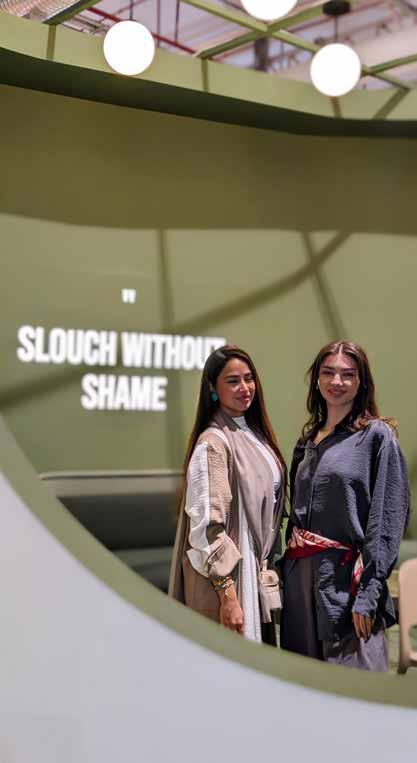
Roar’s involvement brought essential insight into the Saudi market. “There’s a strong push toward collaboration, openness, and wellness in workplace design here,” Aseel explained. “Our furniture arrangement reflects that, spaces are open, inviting, and designed to support conversation.”
The stand was also a practical showcase for international suppliers. “We specify from a wide network of suppliers,” Aseel added. “Italian, Spanish, Polish, we use a lot of global products in our projects. And partnering with MDD is a great example of how that can work successfully in the region.”


CONTINUED CONVERSATION WITH ASEEL AL TUWAIJRI
FOLLOWING THE MDD COLLABORATION, WE CONTINUED OUR CONVERSATION WITH ASEEL AL TUWAIJRI TO BETTER UNDERSTAND ROAR’S PRESENCE IN THE SAUDI MARKET, AND THE GROWING APPETITE FOR BOLD, FUTURE-FOCUSED DESIGN.
Rooted in Dubai, Growing in Saudi “Roar is based in Dubai, but we’ve been building a presence in Saudi over the last few years,” Aseel explained. “We have a small but focused team here. My colleague Tamara and I are leading projects on the ground, and we work closely with our wider team of interior designers, drafters, and visualisers.”
Roar has already collaborated with major Saudi clients and is actively growing its footprint in the Kingdom. “We’re still in early stages on some of the projects, but there’s a lot of momentum. The scale of opportunity here is unlike anything else in the region right now.”
Saudi Arabia’s design sector is in rapid transformation, and designers on the ground can feel it. “It’s a very exciting time to be working here,” said Aseel. “Projects move fast. Every month I hear about something new, factories relocating here, new suppliers setting up, international brands investing in the local market.”
For Aseel, that momentum brings creative energy and professional drive. “It makes me want to dedicate more of my time to Saudi projects. There’s so much happening, and it’s happening quickly.”
When asked about stylistic trends in Saudi Arabia, Aseel was quick to point out a clear direction: “We’re seeing a lot of interest in futuristic design, clean lines, minimal forms, and flexible materials. It’s elegant, it’s functional, and it allows for future updates. Change the colour palette, and the entire space transforms.”
That adaptability appeals to both designers and clients, especially in a market that’s evolving as rapidly as Saudi Arabia. “There’s something timeless about the futuristic aesthetic. It’s simple but layered, it gives the client room to grow.”
Despite the regional specificity of Roar’s work, the studio thrives on global collaboration. “We work with international suppliers on nearly every project, furniture, materials, lighting. Partnering with MDD is just one example, but it reflects how open the Saudi market is to well-executed global design.”
So what would Aseel say to designers watching the Saudi market from afar? “Come and see it for yourself. There’s a level of innovation here that people don’t always expect. And once you’re here, you’ll realise how much opportunity is waiting.”

CHRISTINE ESPINOSA-ERLANDA, ASSOCIATE DIRECTOR AT GODWIN AUSTEN JOHNSON ARCHITECTS (GAJ), IS AN AWARD-WINNING ARCHITECT WITH MORE THAN TWO DECADES OF EXPERIENCE AND A PROUD ADVOCATE FOR WOMEN AND EMERGING TALENT IN THE BUILT ENVIRONMENT. WITH PROJECTS SPANNING THE MIDDLE EAST AND ASIA, CHRISTINE HAS PLAYED A PIVOTAL ROLE IN SHAPING THE REGION’S ARCHITECTURE, WHILE ALSO GUIDING THE NEXT GENERATION OF PROFESSIONALS THROUGH MENTORSHIP, EDUCATION, AND THOUGHT LEADERSHIP.
At this year’s Index Saudi Arabia, Christine was a key part of the show’s talks programme, appearing across all three days as a panellist and moderator. Between sessions, Design Insider sat down with her to discuss the principles that guide her practice, the importance of platforming diverse voices, and why she never stops learning—even after 20 years in the field.
For Christine, sustainable architecture is a mindset, not a checklist. “We always follow what’s needed, whether that’s LEED Platinum, Mostadam, or Estidama,” she said. “But sustainability starts much earlier than certification. Passive design, environmental sensitivity, and performance strategies are already embedded in every design we do as an architectural firm.”
Her firm takes sustainability seriously at both conceptual and practical levels. “We work closely with sustainability consultants, not just to meet client goals, but often to help them exceed what they imagined. We’re not just trying to ‘tick the box.’ We guide them through what points they can gain, how they can push a little further, and how to futureproof their projects. It’s a holistic part of our design philosophy.”
Christine also spoke about the collaborative nature of their work, especially when it comes to interiors. “We have a great in-house interior design team at GAJ, but we’re working on multiple large-scale projects at the same time, so naturally there are limits,” she explained. “We regularly work with external partners. It’s not a matter of capacity alone, it’s about bringing in the right people for each project.”
Thanks to GAJ’s long history in the region, these relationships are well established. “The company has been here for 36 years, and in that time we’ve built strong connections with trusted subconsultants, what we call our partners. These aren’t just one-time collaborations. They’re part of our ecosystem, and that trust shows in the outcomes. It’s a good mix, and I think that’s reflected in our portfolio and in the kind of responses we get from our clients.”
Christine also walked us through GAJ’s supplier and subcontractor onboarding process, a critical part of ensuring design quality. “We ask suppliers to register with us through our website. There’s a supplier registration form and a pre-


qualification process they need to go through,” she said. “Once that’s submitted, our dedicated team reviews everything.”
She stressed that registration alone isn’t enough. “We don’t just look at paperwork. We look at their portfolio, we look at experience, and we consider client feedback. If a specific project requires a specific product or service, and we’ve vetted that supplier, then we’ll definitely reach out. But everything is reviewed carefully. We do our due diligence on every front.”
As a central figure across the talks programme at Index, Christine took on multiple roles, not just as a speaker, but as a facilitator of dialogue. For her, it’s more than a professional obligation. “It comes from passion,” she said. “I’ve been mentoring young architects, advising universities, and working with organisations like Women in Real Estate. I lead the mentoring programme in our firm, and I’m very close to students and early professionals because I see the gap between education and the real world.”
This is what drives her to show up and speak out. “Being part
of events like this gives me a voice, and it lets me share what I’ve learned over the last two decades. But it’s not about being on stage. It’s about sharing knowledge, creating space for others, and learning myself in the process.”
Christine’s role as a moderator across several sessions was noted by many in attendance for its warmth, balance, and inclusivity. “Moderating isn’t about me,” she said. “It’s about making sure others get to shine.”
She explained the importance of tailoring questions to each panellist’s background and area of expertise. “In one session, I had a panel with an engineer, a lighting designer, a businessman, a project manager, and an architect. All from different disciplines, all speaking on the same topic. So I had to find a way to make the discussion relevant for each one of them, and for the audience.”
Her goal, she said, is simple: “If I ask a question that doesn’t connect to what that person knows deeply, it doesn’t bring value to them, or the audience. My aim is always to help people learn from the discussion. And I learn too.”
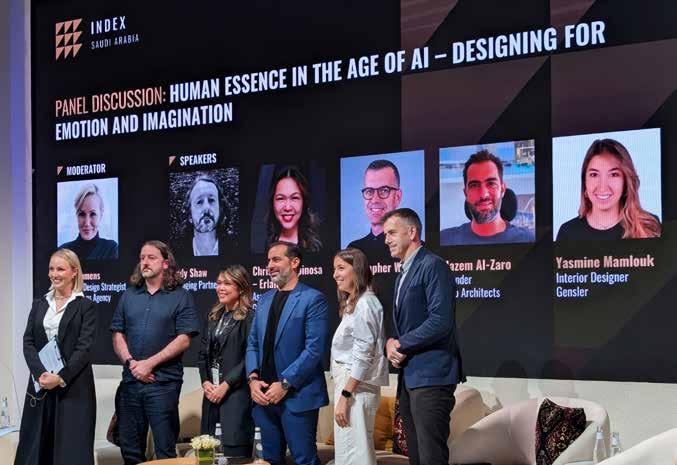
Mentoring and leadership are at the heart of Christine’s role—within GAJ and beyond. “I lead our mentoring and internship programme, and I also sit on the advisory boards for Cityscape Women in Real Estate and Heriot-Watt University’s architecture programme,” she said. “It’s important to me because I’ve been there. I know what it’s like to be a student with big dreams and no idea how to enter the profession.”
She continued, “This is my way of giving back to the profession I love most. It’s about lifting others as we rise.”
That same spirit drove her decision to accept a full three-day commitment at Index, despite the challenge of balancing work, family, and life. “When they asked me to speak across all three days, I didn’t hesitate. The only challenge,” she laughed, “was getting my husband’s blessing and explaining to my kids that ‘Mommy will be away for a while.’ But they understand. They’ve seen me speak before, and they know I care deeply about this work.”
As our conversation closed, Christine reflected on why she continues to stay involved, long after achieving senior leadership status. “I’ve spoken at many events, but what makes them special is the connection,” she said. “I enjoy conversations that go deeper than surface-level trends. I enjoy learning from peers, from panellists, from the audience. Even after 20 years, I’m still growing.”
And what keeps her coming back? “I love what I do. And when you truly love something, you give back to it. That’s why I keep showing up, on stage, in the office, and for the next generation.”
ANDY SHAW, MANAGING PARTNER, AMA
TIME WAS TIGHT WITH ANDY SHARP, CHAIR OF THE RIBA GULF CHAPTER AND ARCHITECT AT AMA, BUT WE MADE IT COUNT! BASED IN DUBAI, ANDY IS IMMERSED IN THE REGION’S MOST AMBITIOUS DESIGN PROJECTS, FROM LARGE-SCALE MASTERPLANS TO FAST-PACED RESIDENTIAL WORK. IN THIS RAPID Q&A, HE SHARES HIS PROFESSIONAL INSIGHTS INTO WHAT IT TAKES TO SUCCEED IN ONE OF THE WORLD’S MOST DYNAMIC ARCHITECTURAL MARKETS.
Tell us who you are and what you do?
I’m Andy Sharp, Chair of the RIBA Gulf Chapter and a practising architect based in Dubai. I work with AMA, where we deliver architecture and interior design projects across Saudi Arabia, the UAE, and the wider Gulf region.
What does your role at RIBA involve?
It connects me to a wider professional community. I’ve always been committed to helping grow the design network here, architects, interior designers, master planners, creating opportunities for collaboration and shared learning.
How do organisations like RIBA support design in the region?
Institutions like RIBA bring credibility and visibility. Their international profile helps open doors, build trust, and facilitate connections across the industry.
What kind of projects have you worked on personally?
As an architect, I’ve contributed to a range of projects including Diriyah Gate in Riyadh, Dubai Harbour Yacht Club, and the Dubai Hills residential community. I’ve also worked on several villa developments across the UAE.
And through RIBA?
We’ve organised exhibitions on themes like sustainability, community engagement, and more recently, AI in the built environment. The goal is to explore key industry topics and encourage broader dialogue.
What do members tell you they value most?
Interestingly, building tours. People really enjoy seeing good design firsthand and learning how things are constructed.
What are some unique demands of working in the Gulf region?
Timelines tend to be very tight. You’re often expected to deliver concept work in a matter of days, or even hours. Things move fast.
What about the client relationships?
Decision-making can be quite hierarchical. You may not always have direct access to the final decision-maker, so the approval process can be less collaborative and more structured.

Is that something international firms need to prepare for?
Absolutely. If you’re new to the region, you’ll need to learn how the process works, or partner with someone who already understands the local systems.
Are there recent projects that stand out as exemplary?
Zaha Hadid Architects’ metro station in Riyadh’s financial district is a great example, beautifully executed and a striking public space. Foster + Partners are doing impressive work in the Red Sea and AlUla regions.
Do you have personal favourites?
I enjoy working on resorts. The natural landscapes in Saudi Arabia, mountains, coastlines, offer incredible settings. It’s a rewarding challenge to design for those contexts.
Have you seen innovation in those projects?
Yes, there’s a noticeable push for originality. Some clients are encouraging distinctive, forward-thinking architecture. Saudi Arabia is using design as a tool to establish its identity on a global stage.
Is the region influencing global architectural discourse?
Increasingly, yes. It’s part of a broader conversation, particularly in climate-responsive design. Some of what’s happening here is comparable to what we see in places like Mexico, Miami, or parts of Asia.
What does Vision 2030 represent to you as an architect?
It’s a massive investment in infrastructure and the built environment—intended to improve quality of life and enhance global perception. Design and architecture are playing a central role in that transformation.
What advice would you give to practices looking to enter the market?
Be prepared to work quickly. Understand the visual language and materials that resonate locally, but more importantly, visit the region. You have to experience it firsthand.
Final thoughts?
Come with an open mind. Don’t rely on assumptions. There’s far more happening here than most people realise.
ACROSS THE SHOW FLOOR, A KEY THEME AMONG FURNITURE EXHIBITORS WAS THE MOVE TOWARD COMPREHENSIVE, TURN-KEY SOLUTIONS, OFFERING NOT ONLY PRODUCTS BUT ALSO DESIGN, FIT-OUT, AND PROJECT SUPPORT TAILORED TO THE HOSPITALITY SECTOR.
Yilka – A Turkish design, manufacture, and fit-out brand founded over 50 years ago. Offering full turn-key services, Yilka has now brought their long-established quality and expertise to Saudi Arabia for the first time.
Leta - Turkish manufacturer Leta presented a fully furnished hotel suite, showcasing their expertise in seating, tables, and complementary furniture for the hospitality sector. With over 40 years of experience in the commercial market, the brand focused on practical comfort, clean lines, and tailored solutions.
OND - Chinese brand OND, already well-established in the Saudi market, showcased its extensive manufacturing capabilities in hospitality furniture.




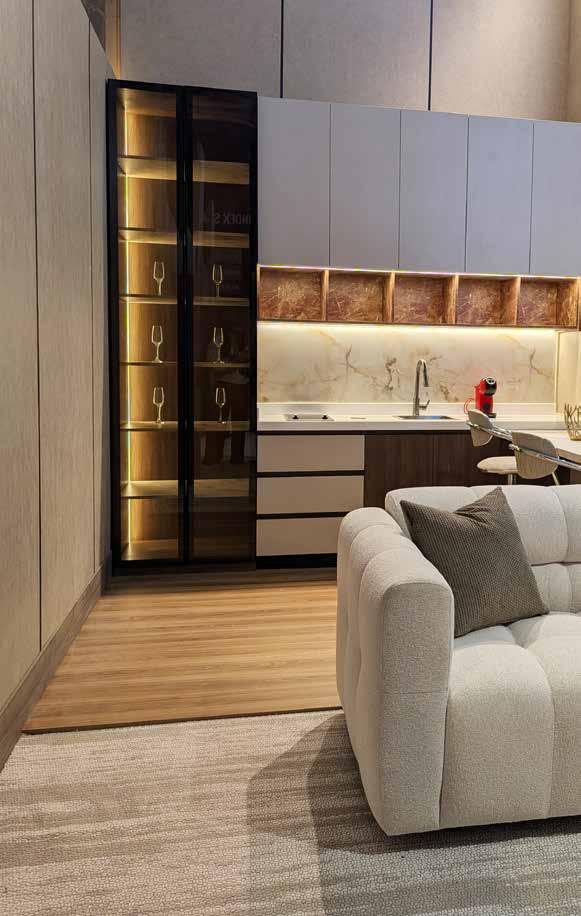
Alaqeel Furniture Factory – A Saudi brand with over 55 years of history. Designing and manufacturing furniture in Saudi for the hospitality sector, with a strong focus on hotel developments.

A Chinese company specialising in drawer and hinge components for wardrobes and kitchens. Already supplying globally, but not yet in the UK.
BATHROOMS WERE A STRONG FOCUS AT INDEX SAUDI ARABIA, WITH LEADING INTERNATIONAL NAMES INCLUDING LAUFEN AND EVENT SPONSOR KOHLER JOINED BY A WIDE MIX OF BRANDS SHOWCASING INNOVATION IN SANITARYWARE AND SYSTEM DESIGN.
ACROSS THE SHOW FLOOR, EXHIBITORS PRESENTED SOLUTIONS THAT COMBINED HERITAGE, TECHNICAL EXPERTISE, AND FORWARD-LOOKING DESIGN. HIGHLIGHTS INCLUDED VILLEROY & BOCH GROUP, TREDEX, AND GEBERIT, EACH BRINGING DISTINCT PERSPECTIVES TO THE SECTOR.
Villeroy & Boch Group – Showcasing several collections alongside partner brand Ideal Standard, including Antar, a post-Covid collection inspired by nature. Antar utilises earthy ceramic tones and brushed metal finishes.
Tredex – Part of a business with a 65-year legacy, though the Tredex brand itself was launched 20 years ago. With a holistic sanitary product portfolio, international manufacturing (including in the UK), and collaborations with Karim Rashid, Tredex primarily supplies across the GCC but is looking towards Europe and the UK for expansion.
Geberit – As the first supplier to pioneer in-wall framework, Geberit has set benchmarks in sanitary technology. Its products and systems are designed for global markets, combining technical reliability with design flexibility. At INDEX Saudi Arabia, Louise Pitt, Head of Marketing and Communications in the Gulf, emphasised the brand’s commitment to innovation and to meeting the region’s evolving needs.

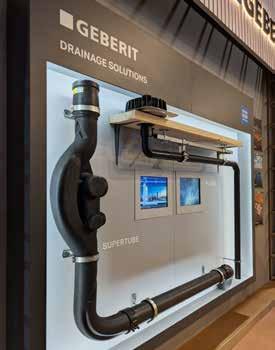

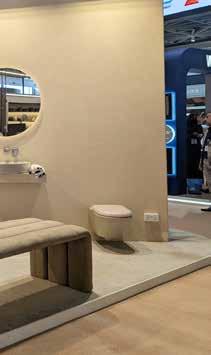
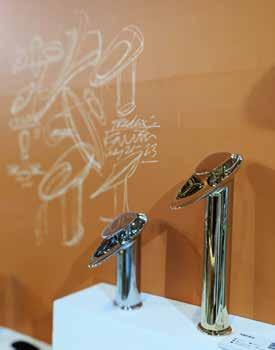
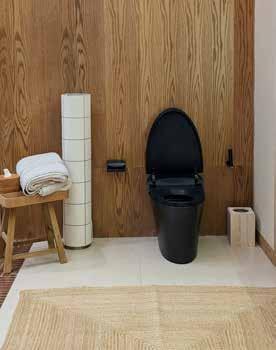


IDEAL STANDARD
Quinti – Established in 1976, Italian manufacturer Quinti collaborates with global designers to deliver furniture for the workplace and hospitality sectors. Returning for their third participation in Saudi Arabia, the brand recognises the Kingdom as a strong and growing market for their collections.
Harman Hotel Furniture – Founded in 1997, Harman (also known as Harman Furniture Group or Harman Furnishings) is a Chinese specialist in luxury hotel furniture, furnishings, and fit-out solutions. Operating from Foshan and other manufacturing hubs, Harman delivers turnkey furniture packages, fixed-furniture systems, and custom interiors for hotels, resorts, yachts, and high-end residential projects.



THE ITALIAN PAVILION WAS A SUBSTANTIAL PRESENCE AT INDEX SAUDI ARABIA, FEATURING THREE LARGE GROUP STANDS THAT COLLECTIVELY REPRESENTED A WIDE SPECTRUM OF PRODUCT TYPES. DISTINCTIVELY, IT WAS AMONG THE FEW AREAS OF THE EXHIBITION TO HIGHLIGHT ACCESSORIES, SCENTS, AND DECORATIVE ITEMS.
Mangani1958 – An Italian tableware brand, founded in 1958 and now led by the third generation of its founding family. Designing and producing in Italy, Mangani has established a strong presence in Saudi by developing collections that respond to cultural and domestic needs.
Logevy – The Florentine fragrance house Logevy (Firenze 1965) brought a distinctly sensory dimension to the Italian Pavilion, specialising in room fragrances, body care, and scented accessories rooted in Tuscan tradition. Their collections draw from perfumer Stefano Cintelli’s memories and inspirations of Tuscany, combining natural essences, elegant presentation, and a refined artisanal approach.
Pinetti – A Bergamo-based Italian brand renowned for its handcrafted luxury accessories, Pinetti blends artisanal leatherwork with modern design to produce distinctive décor pieces, trays, vases, and bathroom objects. At INDEX, Pinetti’s presence stood out for adding decorative texture to the pavilion — a reminder that accessories and finishing touches are increasingly integral to holistic interior vision. and guest experience.



